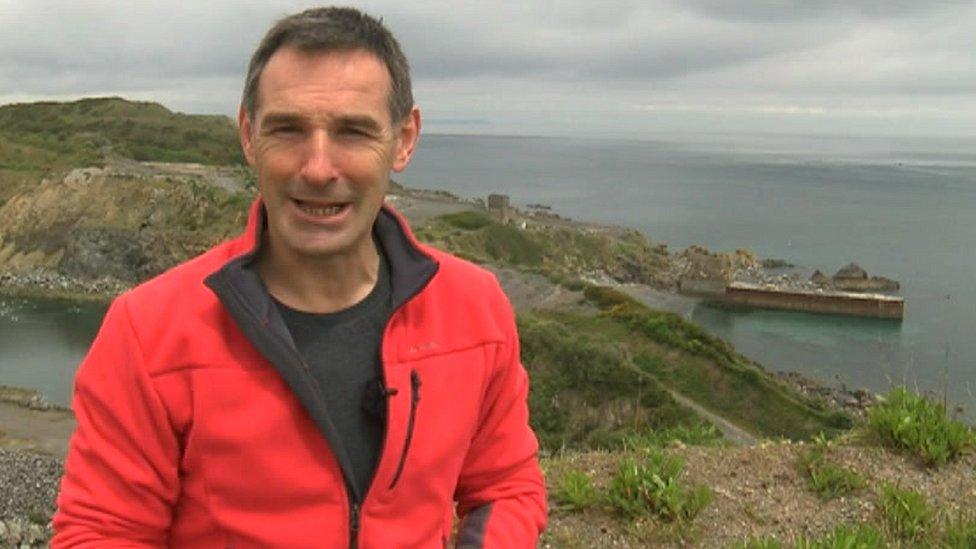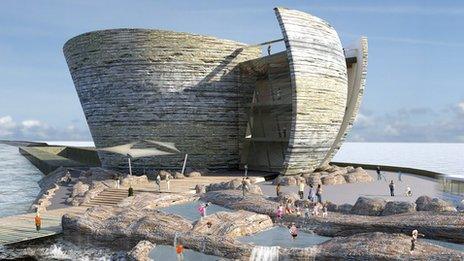Swansea Bay's £1bn tidal lagoon hit by delay
- Published
BBC Wales environment correspondent Iolo ap Dafydd with the nuts and bolts of the tidal lagoon project - in 60 seconds
The building of a £1bn tidal energy lagoon in Swansea Bay has been delayed by a year as negotiations over the level of UK government funding for the project continue.
Tidal Lagoon Power (TLP) received backing by the Department of Energy and Climate Change (DECC), external in June.
TLP said it had taken a "pragmatic" decision to delay construction, as talks are ongoing over how much electricity subsidy will be paid.
Work was due to get under way in 2016.
TLP is also waiting for a marine licence from Natural Resources Wales and a lease from the Crown Estate.

A spokesman for TLP said: "Our Board has updated the target for the construction programme.
"The building needs to start in the spring, but first we need the remaining permissions, CfD (contract for difference) and financial close. So the pragmatic decision for spring 2016 is to move to spring 2017."
The CfD deal is crucial - as it sets out how much the government is willing to pay towards the energy generated.
'Dithering'
The Welsh government accused the UK government of "dithering over funding".
A spokesman said: "Earlier this week we saw the closure of Mabey Bridge in Monmouthshire due to disarray in the UK Government's energy policy and now we face the prospect of a delay to this major project because of dithering over funding from the UK Government.
"We will continue to push the UK Government to ensure this ambitious project is realised and brings significant benefits to Wales."
The tidal lagoon on the eastern side of Swansea Bay, between the docks and the new university campus, would use the flow and ebb of the tide to generate energy, which would then be converted into electricity.
Tidal Lagoon Power says it will now negotiate how much subsidy will be paid for the energy
But before the lagoon becomes a reality, there are two main challenges that need to be met:
The estimated cost of the project has almost doubled to £1bn. To make this scheme possible, a UK government subsidy for the power generated - a strike price - has to be agreed. The company is asking for a higher incentive than wind turbines, solar power and nuclear.
Environmental concerns regarding silting, sand dredging and potential impact on fish have to be addressed before a marine licence to allow the lagoon to be built can be issued.
Thousands of construction and manufacturing jobs could be created, especially if five much bigger lagoons are built in the Severn estuary and off the north Wales coast.
It could also boost to the UK's standing as a generator of clean, green energy.

Analysis
BBC Wales environment correspondent, Iolo ap Dafydd

Three elements are needed before Swansea's lagoon can be built - a marine licence by NRW, a lease agreement with Crown Estate and most importantly a subsidy for the power generated of £168 per megawatt hour (pmh) of energy generated.
So far DECC officials and ministers are taking their time.
Why? Well because this governmental support that's been requested is the most expensive yet. Hinkley C's proposed nuclear plant will - if built - receive between £89-£92.50/pmh.
Also, the support requested is over a 35 year period.
This support is public money, at a time when austerity cuts have come thick and fast in many public services.
According to DECC there's no specific timetable for the financial negotiations, and it is pursuing a diligence process to assess TLP's plans.
The weather is also of critical importance - any construction out to sea has to start during the spring to allow enough work to be done at a time of expected good weather. It's thought to be too much of a risk to start work mid-summer or during the autumn.
What excites the UK government is that the Swansea lagoon if seen to be successful, could lead to a string of other lagoons - much larger ones near Cardiff, Newport and Colwyn Bay.
They could be generating power for up to a 120 years through the regularity of the tides.
Another pressing issue is that a quarter of Britain's power plants could be decommissioned in the next 10 years, and the fear is there won't be enough replacement power in the national electricity grid. That could lead to sporadic blackouts.

How would the lagoon work?
Watch Tidal Lagoon Power's video of how the turbines would work
A six-mile long seawall loops two miles out to sea from close to the mouth of the River Tawe and Swansea Docks and makes landfall close to Swansea University's new Fabian Way campus to the east.
It would house 16 underwater turbines generating electricity on both the rising and falling tide.
Enough renewable power would be produced for 155,000 homes (equivalent to 90% of Swansea Bay's annual domestic electricity use) for 120 years.
Source: Tidal Lagoon Power Ltd
- Published18 March 2015

- Published7 February 2014
